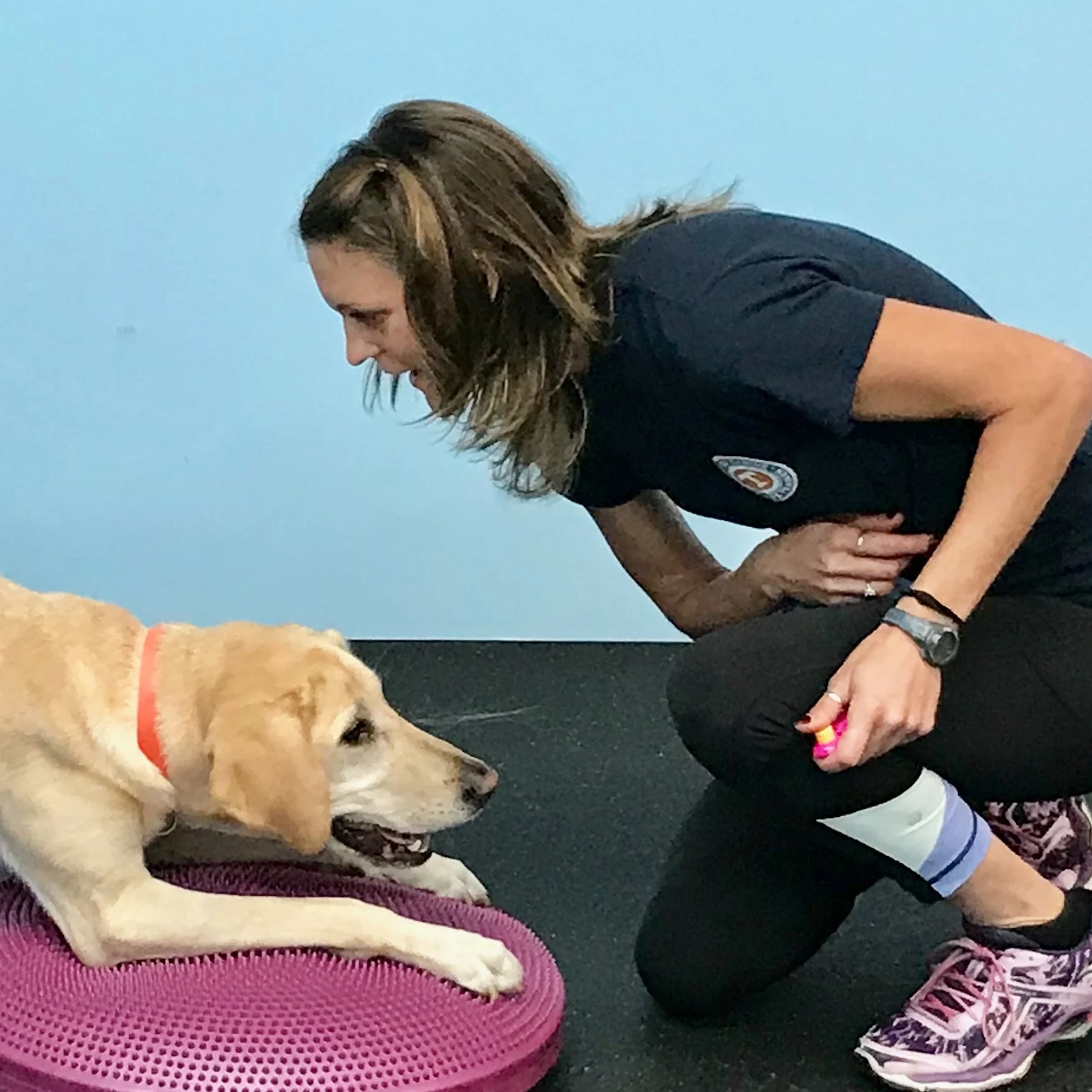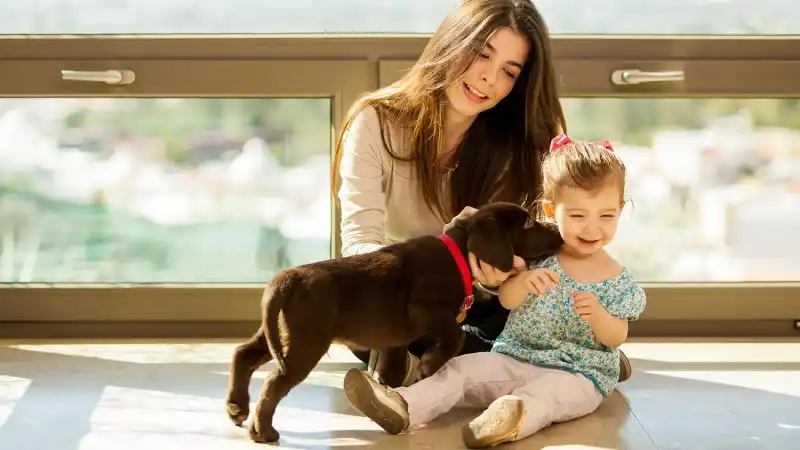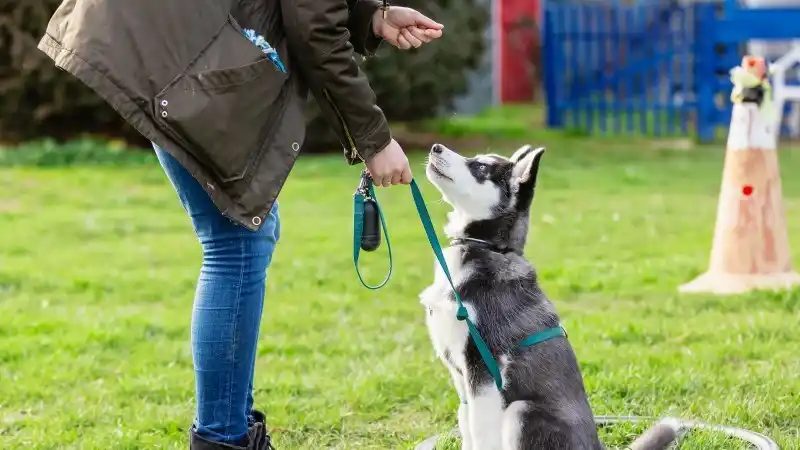Signs It's Time to End a Training Session
Like humans, dogs experience training fatigue. Learn tips on training session length, signs your pet has become exhausted & how to keep them engaged.

It’s easy to lose track of time when you are engaged in learning a new, fun skill with your best friend during a training program. Your dog is constantly communicating to you with their body posture and gestures during obedience training, but there are times when they may be trying to tell you that dog fatigue has set in. Read on to learn how your dog may indicate to you that the training session is over because their energy level is declining.
How Long Should a Dog Training Session Be?
“[Dog] Training sessions should be short and have a specific goal in mind. You want to leave your dog wanting more training fun! Overtraining can lead to a lack of interest from your dog,” says Kirsten Holt, professional dog trainer and owner of Wycked Fit K9 in Beavercreek, Ohio. “Fatigue may occur in a pet obedience session, during a canine fitness workout, or in an everyday life situation - such as taking your dog out to eat at a dog-friendly restaurant patio.”
Watch for These Exhausted Dog Symptoms
If their energy level has dropped, a dog cannot perform a skill as well as they usually do. You may see a pitter patter of feet that should be still or your dog may step off of canine fitness equipment. Your dog may also be unable to hold positions as long as they could earlier in their session. They may also shift their weight differently – perhaps their rear end is tired, and you see them shift body weight forward to their forelimbs. In short, they give you subtle or strong clues that they are done performing this skill and need a break, or are done with the session altogether.
Your dog's interest in their treats or the way they take treats changes. For example, they spastically take treats despite taking them gently earlier. Signs of “short-circuiting” may include this deterioration of their bite inhibition or the ability to make slow, deliberate movements, such as taking treats gently from your hand. Conversely, some dogs stop taking treats to indicate they are physically full (no room in the stomach to consume more treats) or are simply not interested in working for that type of reward anymore!
A dog in training vocalizes frustration, despite being quiet earlier in the session. Basically, your dog gives you a frustrated, bossy, and piercing bark or grumble. This may indicate tiredness or that they are confused by what you are asking of them. If your dog is confused, read this blog on how to become aclear canine communicator.
If your dog is too busy to follow commands, training time may be over. Likewise, if they yawn several times, offer up multiple sneezes, scratches, pants, or sniffs at the ground, it's probably time to wrap things up. These are all ways your dog communicates to you that they cannot -- or do not want to -- do the task you are asking of them. This could be due to weariness or because you made the skill too challenging – if so, you may need to go back to an easier version of that same skill.
Your dog's form may deteriorate. “During canine fitness training, a change in the proper form is an indicator that the training session should end. The dog is now using the wrong muscles to attempt to do the task, which could lead to injury,” continues Holt. “A canine fitness training professional can help coach you through the signs of proper and improper form, such as a widening hind limb stance, sprawled sit, or even turned-out elbows.” Form may also decline in non-canine fitness training – keep your eye on your dog and realize when you see their body posture changing due to being dog-tired.
Lethargy in dogs during training may cause your pup to actively look for escape routes or make a visible effort to retreat from the training area. Their eyes may search the room for an exit, they might flick their tongue, offer other canine calming signals, or simply wander off.
In some cases, the doggy payoff (treat) may not be valuable enough, so you might need a better reinforcer during training sessions. Try switching treats around so your trainee doesn't get bored with what's being offered. In some cases, however, your dog is likely exhausted, and in these instances, training should just end, according to most certified canine fitness trainers.
What to Do When Canine Fatigue Strikes
“Listen to what your pup is telling you and end the training session,” advises Holt. “Look for your dog’s signs of fatigue sooner in your next session. You may reduce the sets and/or reps of exercises to give your dog a chance to build strength for progressions. It takes time for muscles to rebuild, recover, and become stronger before progressing in an exercise program.”
Often, owners are advised to do one last skill so that the dog and human end the session feeling successful and happy. If your dog loves doing an easier skill such as the nose touch, ask for a nose touch and give a treat.
Some dogs may be so fried at this point that they cannot even accomplish this simple skill. In these cases, it may be best to just end the session with a fun game instead of a skill. Scatter some treats on the floor so that your dog can play “sniff and eat.” Put some kibble in a dog puzzle toy or snuffle mat. If your dog enjoys playing with toys, consider a quick tug session.
How Long Should You Train Your Dog a Day?
The saying “quality over quantity” applies here. It is often better to do multiple, short training sessions in one day. Your dog training session length might only be 10 seconds to two minutes in duration! Over time, some dogs can focus for longer periods, such as up to 15 minutes. And, it's important to remember that a puppy will have an even shorter attention span than an adult dog.
“Keep your human state of mind and human energy level in mind. You may need to take a training break due to your own fatigue to keep your dog’s success rate high. You can always do another session later,” Holt explains.
Where Can I Learn More About Canine Fitness?
Stay tuned for more dog fitness blogs! In addition, to find classes near you or to learn more about how to safely do beneficial calisthenic choreography for your dog, find a Certified Canine Fitness Trainer (CCFT). A CCFT can guide you in program design and in the proper number of repetitions and sets per exercise. Besides being a lot of fun, engaging in canine fitness helps keep your dog at an appropriate weight, staves off heart disease, and makes them physically fit.
Doing fitness exercises with proper form can help prevent injuries and ensure your pup recuperates faster when they do get injured. Just as humans check with their doctors before engaging in new fitness routines, dog owners should check with their veterinarians before proceeding with any strenuous training. If you ever see any changes in your dog’s health or notice that they are experiencing any discomfort, stop all activity and contact your veterinarian.
Take some of the stress out of pet ownership with Accident & Illness Coverage from AKC Pet Insurance (underwritten by Independence American Insurance Company). Our pet insurance plans are designed to be there when you need them, allowing you to focus more on the health of your pet and less on costly veterinary bills.

Every Dog and Cat Deserves the Pet Insurance of Champions
Get prize-winning care for your pets.

Jasey Day holds the Certified Canine Fitness Trainer (CCFT) credential through the University of Tennessee. She is a member of the Bobbie Lyons K9FITteam - a team of compassionate canine fitness instructors who actively teach others and continually expand their own knowledge. Since 2004, Jasey has taught a variety of workshops and classes on the following: Puppy, Canine Good Citizen/Family Pet, Advanced Family Pet, Canine Fitness, Canine Swimming, Rally, and Agility. In addition, Jasey has earned over 60 titles in Dock Diving, Agility, Rally, CGC and Trick Dog. Jasey has worked full time for the American Kennel Club since 2007 and teaches at Care First Animal Hospital in Raleigh, NC. Jasey’s Labrador Retrievers spend their free time hiking, training, and snuggling with Jasey.
READ MORE ARTICLES

